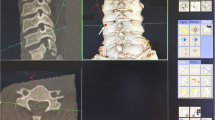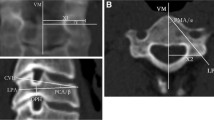Abstract
The present study was performed to determine the optimal entry points and trajectories for cervical pedicle screw insertion into C3–7. The study involved 40 patients (M:F = 20:20) with various cervical diseases. A surgical simulation program was used to construct three-dimensional spine models from cervical spine axial CT images. Axial, sagittal, and coronal plane data were simultaneously processed to determine the ideal pedicle trajectory (a line passing through the center of the pedicle on coronal, sagittal, and transverse CT images). The optimal entry points on the lateral masses were then identified. Horizontal offsets and vertical offsets of the optimal entry points were measured from three different anatomical landmarks: the lateral notch, the center of the superior edge and the center of lateral mass. The transverse angle and sagittal angles of the ideal pedicle trajectory were measured. Using those entry points and trajectory results, virtual screws were placed into the pedicles using the simulation program, and the outcomes were evaluated. We found that at C3–6, the optimal entry point was located 2.0–2.4 mm medial and 0–0.8 mm inferior to the lateral notch. Since the difference of 1 mm is difficult to discern intra-operatively, for ease of remembrance, we recommend rounding off our findings to arrive at a starting point for the C3–6 pedicle screws to be 2 mm directly medial to the lateral notch. At C7, by contrast, the optimal entry point was 1.6 mm lateral and 2.5 mm superior to the center of lateral mass. Again, for ease of remembrance, we recommend rounding off these numbers to use a starting point for the C7 pedicle screws to be 2 mm lateral and 2 mm superior to the center of lateral mass. The average transverse angles were 45° at C3–5, 38° at C6, and 28° at C7. The entry points for each vertebra should be adjusted according to the transverse angles of pedicles. The mean sagittal angles were 7° upward at C3, and parallel to the upper end plate at C4–7. The simulation study showed that the entry point and ideal pedicle trajectory led to screw placements that were safer than those used in other studies.




Similar content being viewed by others
References
Reinhold M, Bach C, Audige L, Bale R, Attal R, Blauth M, Magerl F (2008) Comparison of two novel fluoroscopy-based stereotactic methods for cervical pedicle screw placement and review of the literature. Eur Spine J 17:564–575. doi:10.1007/s00586-008-0584-2
Neo M, Sakamoto T, Fujibayashi S, Nakamura T (2005) The clinical risk of vertebral artery injury from cervical pedicle screws inserted in degenerative vertebrae. Spine (Phila Pa 1976) 30:2800–2805
Abumi K, Shono Y, Ito M, Taneichi H, Kotani Y, Kaneda K (2000) Complications of pedicle screw fixation in reconstructive surgery of the cervical spine. Spine (Phila Pa 1976) 25:962–969
Ugur HC, Attar A, Uz A, Tekdemir I, Egemen N, Caglar S, Genc Y (2000) Surgical anatomic evaluation of the cervical pedicle and adjacent neural structures. Neurosurgery 47:1162–1168 (discussion 1168–1169)
Abumi K, Itoh H, Taneichi H, Kaneda K (1994) Transpedicular screw fixation for traumatic lesions of the middle and lower cervical spine: description of the techniques and preliminary report. J Spinal Disord 7:19–28
Abumi K, Kaneda K (1997) Pedicle screw fixation for nontraumatic lesions of the cervical spine. Spine (Phila Pa 1976) 22:1853–1863
Karaikovic EE, Kunakornsawat S, Daubs MD, Madsen TW, Gaines RW (2000) Surgical anatomy of the cervical pedicles: landmarks for posterior cervical pedicle entrance localization. J Spinal Disord 13:63–72
Ludwig SC, Kramer DL, Balderston RA, Vaccaro AR, Foley KF, Albert TJ (2000) Placement of pedicle screws in the human cadaveric cervical spine: comparative accuracy of three techniques. Spine (Phila Pa 1976) 25:1655–1667
Ludwig SC, Kramer DL, Vaccaro AR, Albert TJ (1999) Transpedicle screw fixation of the cervical spine. Clin Orthop Relat Res 359:77–88
Zheng X, Chaudhari R, Wu C, Mehbod AA, Transfeldt EE (2010) Subaxial cervical pedicle screw insertion with newly defined entry point and trajectory: accuracy evaluation in cadavers. Eur Spine J 19:105–112. doi:10.1007/s00586-009-1213-4
Johnston TL, Karaikovic EE, Lautenschlager EP, Marcu D (2006) Cervical pedicle screws vs. lateral mass screws: uniplanar fatigue analysis and residual pullout strengths. Spine J 6:667–672
Jones EL, Heller JG, Silcox DH, Hutton WC (1997) Cervical pedicle screws versus lateral mass screws. Anatomic feasibility and biomechanical comparison. Spine (Phila Pa 1976) 22:977–982
Rhee JM, Kraiwattanapong C, Hutton WC (2005) A comparison of pedicle and lateral mass screw construct stiffnesses at the cervicothoracic junction: a biomechanical study. Spine (Phila Pa 1976) 30:E636–E640
Dunlap BJ, Karaikovic EE, Park HS, Sokolowski MJ, Zhang LQ (2010) Load sharing properties of cervical pedicle screw-rod constructs versus lateral mass screw-rod constructs. Eur Spine J. doi:10.1007/s00586-010-1278-0
Abumi K, Ito M, Kaneda K (2000) Surgical treatment of cervical destructive spondyloarthropathy (DSA). Spine (Phila Pa 1976) 25:2899–2905
Abumi K, Kaneda K, Shono Y, Fujiya M (1999) One-stage posterior decompression and reconstruction of the cervical spine by using pedicle screw fixation systems. J Neurosurg 90:19–26
Abumi K, Shono Y, Taneichi H, Ito M, Kaneda K (1999) Correction of cervical kyphosis using pedicle screw fixation systems. Spine (Phila Pa 1976) 24:2389–2396
Oda I, Abumi K, Ito M, Kotani Y, Oya T, Hasegawa K, Minami A (2006) Palliative spinal reconstruction using cervical pedicle screws for metastatic lesions of the spine: a retrospective analysis of 32 cases. Spine (Phila Pa 1976) 31:1439–1444. doi:10.1097/01.brs.0000219952.40906.1f
Yukawa Y, Kato F, Ito K, Horie Y, Hida T, Nakashima H, Machino M (2009) Placement and complications of cervical pedicle screws in 144 cervical trauma patients using pedicle axis view techniques by fluoroscope. Eur Spine J 18:1293–1299. doi:10.1007/s00586-009-1032-7
Karaikovic EE, Daubs MD, Madsen RW, Gaines RW (1997) Morphologic characteristics of human cervical pedicles. Spine (Phila Pa 1976) 22:493–500
Panjabi MM, Duranceau J, Goel V, Oxland T, Takata K (1991) Cervical human vertebrae. Quantitative three-dimensional anatomy of the middle and lower regions. Spine (Phila Pa 1976) 16:861–869
Shin EK, Panjabi MM, Chen NC, Wang JL (2000) The anatomic variability of human cervical pedicles: considerations for transpedicular screw fixation in the middle and lower cervical spine. Eur Spine J 9:61–66
Onibokun A, Khoo LT, Bistazzoni S, Chen NF, Sassi M (2009) Anatomical considerations for cervical pedicle screw insertion: the use of multiplanar computerized tomography measurements in 122 consecutive clinical cases. Spine J 9:729–734
Ruofu Z, Huilin Y, Xiaoyun H, Xishun H, Tiansi T, Liang C, Xigong L (2008) CT evaluation of cervical pedicle in a Chinese population for surgical application of transpedicular screw placement. Surg Radiol Anat 30:389–396. doi:10.1007/s00276-008-0339-0
Sakamoto T, Neo M, Nakamura T (2004) Transpedicular screw placement evaluated by axial computed tomography of the cervical pedicle. Spine (Phila Pa 1976) 29:2510–2514 (discussion 2515)
Karaikovic EE, Yingsakmongkol W, Gaines RW (2001) Accuracy of cervical pedicle screw placement using the funnel technique. Spine (Phila Pa 1976) 26:2456–2462
Kotani Y, Abumi K, Ito M, Minami A (2003) Improved accuracy of computer-assisted cervical pedicle screw insertion. J Neurosurg 99:257–263
Lu S, Xu YQ, Lu WW, Ni GX, Li YB, Shi JH, Li DP, Chen GP, Chen YB, Zhang YZ (2009) A novel patient-specific navigational template for cervical pedicle screw placement. Spine 34:E959–E966. doi:10.1097/BRS.0b013e3181c09985
Chazono M, Soshi S, Inoue T, Kida Y, Ushiku C (2006) Anatomical considerations for cervical pedicle screw insertion: the use of multiplanar computerized tomography reconstruction measurements. J Neurosurg Spine 4:472–477
Yukawa Y, Kato F, Yoshihara H, Yanase M, Ito K (2006) Cervical pedicle screw fixation in 100 cases of unstable cervical injuries: pedicle axis views obtained using fluoroscopy. J Neurosurg Spine 5:488–493
Conflict of interest
None.
Author information
Authors and Affiliations
Corresponding author
Rights and permissions
About this article
Cite this article
Lee, DH., Lee, SW., Kang, S.J. et al. Optimal entry points and trajectories for cervical pedicle screw placement into subaxial cervical vertebrae. Eur Spine J 20, 905–911 (2011). https://doi.org/10.1007/s00586-010-1655-8
Received:
Revised:
Accepted:
Published:
Issue Date:
DOI: https://doi.org/10.1007/s00586-010-1655-8




